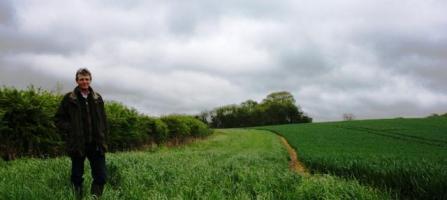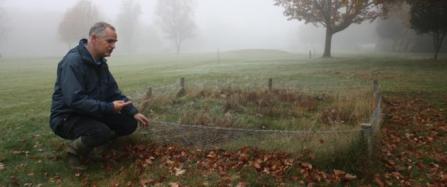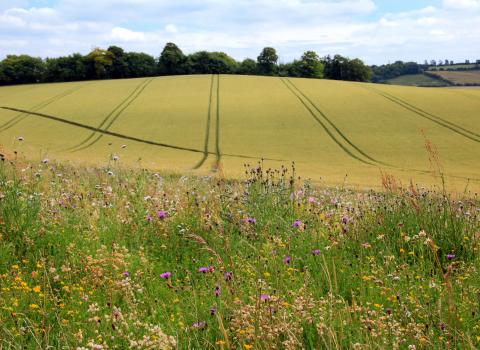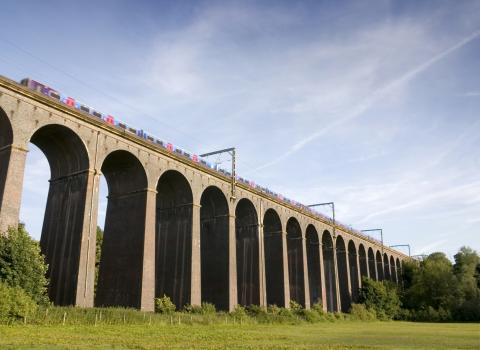Living Landscapes
Preserving species in tiny pockets of the landscape, on our nature reserves, will not ensure wildlife's future survival. Our vision must be wider than that. By creating spaces for wildlife to live in amongst houses, businesses, roads, railway lines and fields we can move closer to our vision of an environment rich in wildlife for everyone.
Towns & Cities Transport Networks
We must start to restore nature across the landscape, not just on nature reserves, and we need to act now. Habitats continue to be lost and many UK species are in long term decline.
Our guide How to Build a Living Landscape shows how different places in Hertfordshire and Middlesex can contribute and provides practical solutions in our towns and cities, on farmland, across our transport networks and on golf courses.
Farming is such an important land use in Hertfordshire. Farmers are the stewards of the majority of our local ecosystems. There are lots of opportunities to restore nature and agri-environment funding schemes are available to help.
Wildflower-rich field margins
Native wildflowers and grasses along field margins will support a diversity of crop-pollinating insects and allow whole ecosystems to thrive. Six to ten metre wide strips are ideal. It's important to link margins up between fields, to make habitat corridors. The margins are best planted with a native wildflower seed mix appropriate to the area and soil types.
Hedgerows
Hedgerows, particularly in association with other habitats, can make great wildlife corridors. Thicker, taller hedges with regular trees provide the most benefits. Where hedges have gaps a mixture of native tree planting and traditional hedge-laying can restore them. As well as providing shelter, hedgerows act like a larder for all sorts of wildlife: nectar in the spring supports butterflies and other insects, while berries help small mammals and birds such as redwings and fieldfares through the winter months.
Habitat creation on poor soils
Reverting arable land back to species-rich grassland can be a way of achieving grant income for fields with poor crop productivity. The most valuable grasslands are made up of species native to the area and take into account the local soil and drainage conditions.
Buffer strips along rivers
Buffer zones of longer vegetation between farmed land and rivers prevent erosion of the river banks by livestock and pollution of the river water from livestock urine and faeces. A buffer zone also helps to prevent herbicides, pesticides and fertilisers from draining off fields into the river. Otters, water voles and other aquatic and bankside wildlife will benefit. Buffer strips can be provided either by fencing or by leaving three metres unploughed next to the river bank. Where cattle need to access the river, concrete 'drinkers' can be installed to prevent soil erosion.
Case Study

Nicholas Buxton on the Easneye Estate
Nicholas Buxton farms the Easneye Estate, which lies alongside the Wildlife Trust’s Amwell Nature Reserve. He has an impressive track record for wildlife conservation.
The Easneye Estate won the Cambs and Herts FWAG (Farming and Wildlife Advisory Group) Farm Conservation competition in 2012, and it’s not hard to see why.
Links across the landscape
The estate is a mixed landscape, with areas of steeper ground that were once dairy pastures, arable land with hedgerows and spinneys, blocks of ancient woodland and the River Ash running through. The key, Nicholas explains, is to try to link areas together – connecting bits of woodland with hedgerows, hedgerows with field margins and field margins with grass margins that run down towards the river.
River restoration
Previously sluggish and damaged by dredging in the 1970s, work has been done to the River Ash to improve the flow with the help of nifty in-channel deflectors and channel narrowing. The non-native signal crayfish has so far not invaded the upper reaches of the river, and native populations of trout and grayling are growing. Sightings of cormorants have increased, indicating there is plenty for them to feed on.
Over 5,750 metres of grass buffer strips now run alongside the river, which, as well as providing habitat for bankside wildlife such as water voles, will prevent arable run off and flooding. It’s likely that the work along the river to control mink has resulted in the return of the water vole to Widford dairy pastures nearby.
Hedges, trees and margins
Hedgerows and trees are very important for wildlife. So far at Easneye over five kilometres of hedgerow coppicing and gap-filling has been achieved, with more than one kilometre of new hedgerow planted through Entry/Higher Level Stewardship. These are grant schemes open to all farmers to help with environmental management. In addition hundreds of hedgerow trees have been planted. Nicholas is confident about the work carried out so far: “The tree planting and hedgerow work is already yielding benefits, but over the years ahead it should be a real improvement.”
For farmland birds, Nicholas points out the importance of providing field margins, so that hedges don’t just lead straight into the arable crop: “You want to have that brood cover, with plenty of insects, through the spring, which is a very important time for chicks.” Grey partridges and lapwings breed on the farm. Seed mixes are planted to provide for birds and nectar/pollen mixes for insects, which are so important for pollinating crops.
Woodland management
Hazel and hornbeam coppicing work started last year, as part of an ongoing programme with the help of the English Woodland Grant Scheme. Thinning allows light to reach the woodland floor, encouraging wildflowers to emerge and
associated wildlife to thrive. The wood that’s removed is sold on as firewood, or used to fuel a woodchip boiler on the estate, making it not only a good solution for wildlife but for the farm’s economy too. The drought has made tree and hedgerow planting difficult over the last two years, but Nicholas is hopeful that the 360 oak trees just planted in hedgerows will take well – and looks forward to them flourishing in the future: “In twenty years I hope to be able to look back on this year as a good thing.”
Sensitive, sensible management
As Nicholas says, estates like Easneye need to be managed. After a number of lean years in farming, there is now the opportunity to put them back in good heart. Active management is as important here on the farm as it is on the Wildlife Trust’s nature reserves. Man has been shaping the landscape for thousands of years; there’s no reason why we shouldn’t continue to do this but in a sensitive way, not only for our own benefit but for the protection of our natural environment and its wildlife too.
There are more than 70 golf courses in Hertfordshire. By their nature they are relatively large areas of countryside, much of which is made up of rougher, less intensively managed land. Managed sympathetically, these areas have huge potential to contribute to a Living Landscape.
The rough
Remnants of ancient grassland remain on some golf courses. By mowing in sympathy with the flowering periods of native plant species, wildflower meadows can be created where the ground has been untouched by chemicals. In other cases, where re-generation is less likely to happen quickly, native wildflower seed mixes can be sown. Zoning the rough will benefit wildlife. Fortnightly mowing of shorter rough will encourage low-growing species like bird's-foot trefoil. Long rough can receive much less attention, allowing taller plants to grow and set seed and providing food and cover over winter for insects, small mammals and reptiles like grass snakes.
Heathland
This is a scarce habitat in Hertfordshire but one which can survive on golf courses, particularly within areas of longer grass where trampling is less likely. Gorse, broom and heather of varying ages and sizes will benefit wildlife the most. Small, young plants provide basking spots for lizards while larger shrubs provide nest sites for birds. Cutting heather with the blades fairly high will imitate the beneficial effects of a grazing herd. Tree removal will help light to reach the seedling plants and encourage growth.
Ponds and lakes
Leaving a natural edge around at least part of a pond or lake will provide cover for aquatic wildlife whilst still allowing golfers to find lost golf balls around the close cut edge. Trees and shrubs add cover for wildlife, although overhanging trees should be cut back on the south side of ponds and lakes, to allow enough light in.
Habitat variety
These golf courses with lots of different types of habitat will attract the most wildlife. Bats will benefit from open grassy areas and expanses of water for feeding, and roost in the trunks of old trees. Grass snakes are particularly suited to golf courses - plenty of water and long grass to hunt in, the sunny bank of a bunker to bask on and compost heaps to lay their eggs in all make a perfect home!
Case study

Terry Crump at Harpenden Common Golf Club
Maintaining a rewarding golf course whilst satisfying the needs of wildlife is a challenge, but it’s something that General Manager Terry Crump embraces at Harpenden Common Golf Club.
The course forms a significant part of Harpenden Common, over 210 acres of woods, heathland, meadows and ponds designated as a Local Wildlife Site, so careful management to protect the wildlife here is important and much welcomed by local people.
The rough and the smooth
It’s necessary to intensively manage parts of the course with regular mowing regimes, but there is room for wildlife in amongst the tees, greens and fairways too, particularly with the longer grass, or ‘rough’. Terry says: “We have seen the benefits of working with Harpenden Town Council through a conservation management plan by letting the rough grow long, and only cutting it once a year.”
Cutting the rough just once a year in July or August means wildflowers have time to set seed and longer grass provides cover for birds, small mammals and insects: “This creates a tougher golf course, for a period. It’s obviously cheaper too as we’re only cutting it once. Sometimes you get complaints as the rough gets too long, but over the years people have got used to it. We always play our club championships prior to the long rough being cut, so it’s as tough as possible!”
Bringing heather back
Harpenden Common is important for its patches of rare heathland and meadow and on the golf course work is being carried out to restore and increase heather and gorse. A careful mowing regime will encourage the heather to spread. Two trial plots where heather has been re-established are growing well; the plots are rabbit-fenced for a period to prevent the nibbling of new shoots but the fencing will eventually be removed once the plants are established. To encourage the heather, shading scrub and trees are trimmed back regularly.
Native species
A number of conifers which act as a barrier between two holes on the course will gradually be replaced with a broadleaved species like hornbeam, which will be much more in keeping with the local habitat. In an area of the course called the Jockey Field, Terry has plans to re-create a wildflower meadow on land that was formerly used for arable farming. Native wildflowers including harebells and thyme grow in an area called the ‘dell’ – an unexpected crater in the ground rumoured to have been dug by Harpenden Town Council to stop enemy planes landing in the Second World War! The grass here is cut in the same way as the other meadow grass in areas of rough: once a year in late summer to allow the wildflowers to bloom and seed.
Ponds
Careful management of the golf course’s pond ensures that wildlife can thrive. Next to the green, grass at the pond’s edge is close cut, but the remaining vegetation is left to grow taller – this pond-side habitat provides excellent shelter for aquatic wildlife and the water is alive with tadpoles in the spring. “The wildlife you see here during the summer is fantastic” Terry confirms. Woodland close to the pond provides overwintering places for the frogs which breed in the pond whilst areas of adjacent rough provide feeding for dragonflies. It’s the mosaic of different habitats, providing for the different parts of life cycles that means so many species live here.
The bigger picture
Sympathetic management of the golf course for wildlife is an important part of the Conservation Management Plan for the whole of Harpenden Common. Creating habitat on the golf course that links to and complements habitats on the rest of the common means more room for wildlife to disperse and adapt. Councillor Bert Pawle, Chair of Harpenden Town Council’s Environment Committee, says: “We endorse and appreciate all the ongoing good work carried out on the common by Harpenden Common Golf Club, which is living proof of how a good working partnership can deliver benefits for us all. We look forward to the involvement of Herts and Middlesex Wildlife Trust in rolling out this next revision of the Conservation Management Plan.” Getting the balance right is vital – and clearly achievable. Terry thinks club members are persuaded too: “I’m sure, with the publicity that you see nationally about the need for biodiversity on golf courses, that the members realise it’s important.” You could argue a golf course managed this way provides challenges which help to develop some of the top talent too. Terry confirms: “We’ve got the best scratch side in Hertfordshire here, a fantastic achievement for a small club like us.”
Herts and Middlesex Wildlife Trust is working in partnership with Harpenden Town Council on the Conservation Management Plan for Harpenden Common.
Urban green spaces and recreation grounds are often managed intensively, with grass cut short very regularly. More natural green spaces, as well as wildlife-rich margins and corridors, can help to build a Living Landscape.
Public green spaces
Parks and other green spaces can be great for wildlife if they incorporate wildflower-rich areas. Local authorities should try to make margins at least three metres wide with larger areas at least 20-30 metres wide in places. Hedges provide food and shelter, and should ideally be up to two metres high, one or two metres thick and with mature trees incorporated every ten metres. Ponds with a diameter greater than 10 metres are ideal - they can be any shape; shallow, sloping sides will help wildlife to get in and out.
Allotments
Nectar-rich plants on allotments will attract useful insects to the plot. Schemes that bring nature back into urban areas, such as creating a wildflower-rich meadow in a shared green space, or digging a pond, can bring residents together.
Street trees
Trees contribute to a healthier environment by producing oxygen and locking away carbon during their normal life cycle. They can act as a buffer to reduce noise pollution and in their immediate vicnity can help to reduce airborne pollution by attracting particles on their leaves. A mixture of native trees is preferable. These should be suitable to the soil type and of local provenance.
Sustainable Urban Drainage Systems (SUDS)
A sustainable system of drainage that can mitigate the effects of urban stormwater run-off on the environment. Ideally these systems should be as naturalised as possible, with thick vegetative margins. From October 2012 any new construction work in Hertfordshire with drainage requirements will need the drainage system approved by the local SUDS approval body.
Our transport corridors are rarely managed with wildlife in mind, despite the fact that they are linear features with the potential to act as corridors for wildlife as well as vehicles.
Roadside habitats
Grassland verges can support a diverse range of species if managed in the right way. Depending on the flowers present, verges are best cut either once in late summer or once in the spring and once in early autumn. This will ensure that tall plants do not cause unnecessary visual obstruction for vehicles, whilst allowing rare species to thrive and set seed. It is really important to collect and remove the cuttings because this reduces soil nutrients, allowing rare wildflowers that thive on poor soil to emerge.
Green cycleways
Good principles of sustainable development aim for the creation of cycle routes to enable people to get between places more sustainably and healthily. This can help to restore networks for wildlife; habitat creation alongside strategically chosen routes can link patches of habitat up and provide a pleasant and relaxing environment to cycle through.
Wildlife crossings
Roads can create significant barriers to wildlife through habitat destruction and fragmentation. Sub-dividing the habitat can even result in extinction of fragile local populations altogether. Wildlife crossings allow animals to cross roads, railways and other man-made barriers safely. A crossing could be an underpass, overpass (or ecoduct), green bridge, amphibian/small mammal tunnel or viaduct. Integrating environmental factors in the earliest phases of road design prevents fragmentation of habitats and can reduce injury or death from wildlife-motorist collisions.
Lineside habitats
Habitats alongside railway lines can provide for birds, insects, small mammals and plants. Species commonly linked to lineside habitats include reptiles, kestrels, orange-tip butterflies, great spotted woodpeckers and bats.


